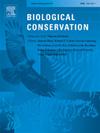Ecological Peace Corridors: A new conservation strategy to protect human and biological diversity
IF 4.9
1区 环境科学与生态学
Q1 BIODIVERSITY CONSERVATION
引用次数: 0
Abstract
In a highly anthropized world with increasing human conflicts and a global call for expanding both protected and indigenous areas, we must reevaluate the importance of corridors. Here I propose a new conservation tool, called Ecological Peace Corridors (EPCs), as crucial for preserving biodiversity and encouraging peacekeeping. These corridors can facilitate wildlife movement and genetic exchange, counteracting the fragmentation caused by human activities. The importance of EPCs will grow as habitat fragmentation increases, highlighting the need for proactive conservation strategies and sustainable land-use planning. The 30 × 30 initiative aims to expand protected areas but to reach its full potential, it must be paired with rewilding and land-sharing strategies. Rewilding restores ecosystems to their natural states, enhancing ecological processes and resilience, while land sharing integrates conservation into human-dominated landscapes, promoting coexistence and connectivity. Buffer zones, part of the EPC framework, reduce conflicts by providing neutral spaces, thus enhancing safety for humans and wildlife. These efforts boost habitat connectivity, genetic diversity, and ecosystem resilience, aligning with global conservation goals. EPCs, by promoting biodiversity preservation and geopolitical stability, offer a solution to challenges like biodiversity loss, climate change, and human conflict. Their successful implementation requires international cooperation, long-term planning, and a commitment to both ecological and human well-being. A methodology for identifying EPCs is here proposed and includes the use of AI-ML for land cover classification, gap analysis to identify priority areas, and Least Cost Path (LCP) analysis to optimize corridor routes by balancing ecological needs with social considerations. The Italian zonation system of National Parks is suggested as a model for planning EPCs, balancing conservation and human needs. Therefore, EPCs can address environmental and geopolitical challenges in conflict zones by removing military infrastructures, restoring vegetation, establishing patrolled corridors, fostering biodiversity conservation and peacebuilding. This approach not only benefits ecosystems and wildlife but also promotes cooperation and trust among neighbouring countries, paving the way for sustainable peace in conflict-affected areas.
求助全文
约1分钟内获得全文
求助全文
来源期刊

Biological Conservation
环境科学-环境科学
CiteScore
10.20
自引率
3.40%
发文量
295
审稿时长
61 days
期刊介绍:
Biological Conservation is an international leading journal in the discipline of conservation biology. The journal publishes articles spanning a diverse range of fields that contribute to the biological, sociological, and economic dimensions of conservation and natural resource management. The primary aim of Biological Conservation is the publication of high-quality papers that advance the science and practice of conservation, or which demonstrate the application of conservation principles for natural resource management and policy. Therefore it will be of interest to a broad international readership.
 求助内容:
求助内容: 应助结果提醒方式:
应助结果提醒方式:


